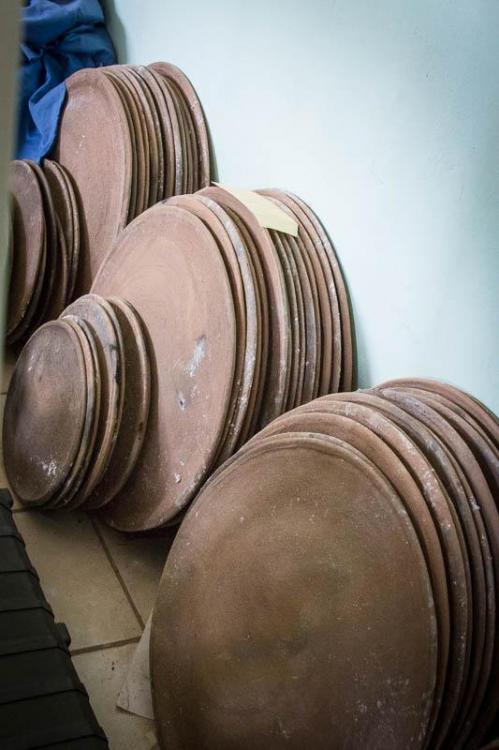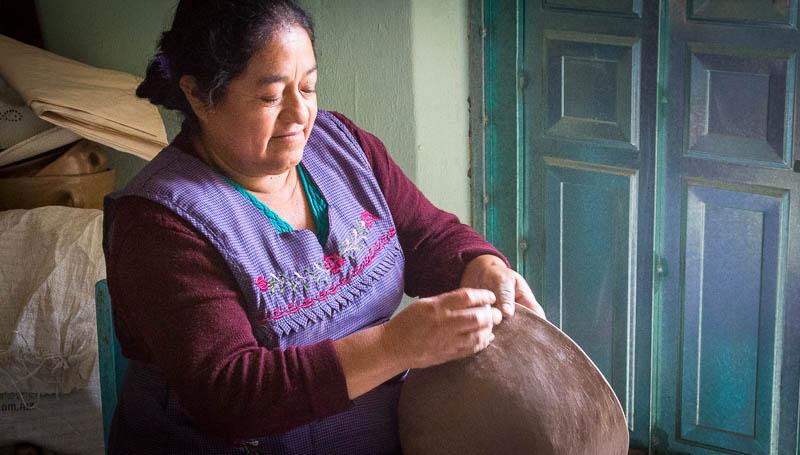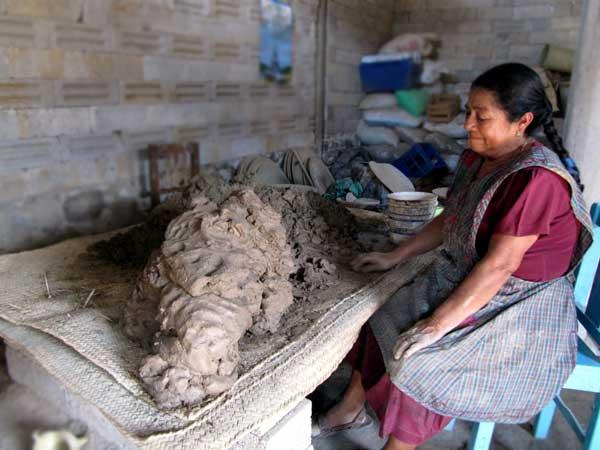-
Posts
1,296 -
Joined
-
Last visited
Content Type
Profiles
Forums
Store
Help Articles
Everything posted by rancho_gordo
-
Thanks. I just got my copy. It's pretty cool! I am officially a media whore, and I mean that in the good way!
-
Sorry, missed this. I have somewhat asbestos fingers but not completely. The handles stay somewhat cool.
-
re salting, I salt at the point that the pot starts smelling like beans. You're right that you want to do it as soon as possible so the beans are salted and not just the broth. If you over salt, you can try adding a potato.
-
Did you see this video I made awhile ago? (It's tongue in cheek about the Magic part.) < >
-
I don't think it would hurt it to cure it at all.
-
I think we're good for at least two months. We are slammed, obviously, but I'm really thankful this article didn't come out before Christmas.
-
Thanks. It's a nice lesson in following your passions. I have to say, this is one of the nicest articles I've ever had done about our work. He got it! And he made it very romantic. And I met JJ Goode here on eG many years ago!
-
No. Now, that seems excessive to me. I just broke in a new pot and didn't do anything and it's doing just fine. If you were concerned, may be soaking it for a few hours is okay. I know other pots have you fill them with water and a garlic clove and cook on low heat until all of the water has evaporated. I think just starting with a low heat and working your way up and using it often should be fine.
-
Thanks, haresfur. Fascinating stuff. I find the deeper I dig, the more interesting this is. And within Mexico, the attributes of the clay vary dramatically. Certain regions are known for their comales, others their ollas, etc. I'm sorry if it doesn't come across online but my interest here is as an enthusiast. There so far is no recipe for making real money in clay pottery that I can see. I love the pots, I cook with them all the time but it seems like I'm coming off as a shill. Sorry about that. I cook in all types of clay, sometimes daily. I would say very clearly, they aren't for everyone. If you want to dig deeper, there are a few great threads here from when Paula Wolfert's seminal Mediterranean Clay Pot Cooking came out. I also co-host a group on Facebook called Cooking with Clay. I'm just the admin there. Most of the posts are from enthusiastic clay pot users and even some makers. But be warned, they seem to really like this Mixteca bean pot.
-
Wow. That's all I have.
-
I appreciate your enthusiasm but but please stop saying breakage is "always a big issue". It's simply not true. It's like saying cooking on gas stove means you will have a fire in your kitchen. It can happen but with a very few steps, it's just not an issue. This pot is not designed to be used in an oven. It would be awkward. A lidded cazuela would be more appropriate if that's what you wanted to do. The bowl that sits on top of the neck opening is for holding water that you can add as needed to the pot (cold water is considered a shock to the beans and thought to keep them from getting soft.) Getting this in and out as needed would be very awkward. But I have a serious "issue" with "collecting" clay pots, especially from Mexico. OK, I am an addict. I have dozens (and dozens) of them. Some cook hotter, some have a more mineral flavor they impart, some taste smokey- they're all different. I cook beans twice a week from this pot, a have three or four cazuelas I use regularly and many other specialty pieces. Knock wood, I have never had one break from direct flame or heat. EVER. They break when well-meaning guests insist on helping with the dishes and drop them on my floor. Or when you accidentally put another piece on top of them without thinking. I also have Italian, French, Spanish, Moroccan and Egyptian pieces. These tend to be just as different and in the case of the Egyptian especially, they're much more delicate and I have had them break from heat. Until you've worked with this clay from this area from these artisans, I don't think you should be speaking in absolutes about it.
-
I think it's ok, i just don't want to be the one to say you must do it. I sometimes saute aromatics in oil or lard in the bottom of the pot before adding the beans and water and soap just seems like a smart idea! If somehow you get a nasty mess, a paste made with water and baking soda is a good idea.
-
Sometimes after things are rolling, I turn the heat down low. I want just the most gentle simmer. I've got all day and the beans don't need rushing. Even at its lowest, it can still be too much, so then I use the simmer mat. But the pot can go right on the flame. Somewhere someone mentioned i recommend soap. I don't! You can if you need it but it should be very little and mild and a thorough rinse. Years ago on a previous clay thread here PaulaWolfert recommended rubbing with olive oil after.
-
1. My fellow Mexican enthusiasts will experience deep pangs of desire, but these are their famous comales. They are huge. We didn't import any of them because they're also somewhat fragile. 2. The famous quartz rock. 3. Lourdes, who runs the whole show. Also one of the nicest women I know and she makes a fabulous mole de chivo.
-
This is one of the women in the collective prepping the clay. There is naturally talc in the clay. After it cooks, the women burnish the pieces with quartz rocks that have been in the family for generations.
-
I'll be blunt, you are sucking the joy right out of this! All I can tell you is that it works really well, it's a gentle heat and the Mixteca people have been cooking for thousands of years with them without ovens. The beans continue to bubble when removed from the fire and stay nice and warm long after the meal is over. I cook twice a week with mine on a gas range. I hear others use electric just fine. We are just about out of them so this isn't a sales pitch, just my experience.
-
The pot will stay much hotter than a metal pot after the fire is turned off. It will keep simmering much longer than it would with a metal pot. I would think that the clay is what's different.
-
I wanted to add the clay holds the heat, so after you bring the beans to an initial boil, you just need a very low to moderate heat to maintain a simmer. The pot does the work, especially if you cook with the lid on and fill the lid with water.
-
I think moving to a home with gas is the best option!
-
The Japanese use these great butane indoor stoves right on the table for communal eating out of a donabe pot: Butane stove
-
I have dozens of clay pots. OK. I have many more than that and it's a problem I can't shake. And I don't want to. These pots are designed for open flames. They can take the heat and the woman who makes them puts them right in the fire and laughed when I asked her about starting slowly and working up to a stronger flame. She doesn't bother. Her concern was a hot pot on a cold surface. She doesn't even cure them. Not all clay pots are the same but these are low fired, unglazed pots and they are built to work. I have heard of glass electric tops breaking but I don't know the specifics of what made that happen. You can put them on the BBQ and they are very happy. You will get grease stains and a patina and it only makes you love the pot more. I have a quick video here for cooking with this pot: https://vimeo.com/148407270
-
Everything I've ever read says this toxin in red beans is killed by regular cooking. Do your beans come to a boil in your slow cooker? Some of the older models didn't bring liquids to a full boil. New ones come with a HIGH setting and you should always use this for beans, at least for the first few hours. Lima beans also pose a special challenge. They also have to be boiled and they also need to cook for some time with no lid to release the gas. But this should be a practice for all slow cooker bean cooking. I put them on in the morning, unsoaked at HIGH and then it goes to LOW automatically after 6 hours. When I come home, I am confused about who did all this glorious cooking all day and then I remember- Me! I remove the lid and let them continue cooking on low for an hour. This allows some air and evaporation which makes the broth much more delicious and apparently releases potentially bad gasses from lima and maybe even red beans.
-
as you will see, there are some pretty wide gaps with different people making the exact same beans from the same lots in the same machine. It seems to me the only variable is water and maybe human error. But it's a good starting point. Deborah madison suggests in general 20 minutes high pressure, slow release, then 20 minutes without the lid. unsoaked beans. If the beans are really no where near done, you can always put them back under pressure. The last 20 minutes with an open lid seems to help breathe life into the bean stock, which is kind of dead with a pressure cooker or slow cooker. The IP is good because it's bringing people into the kitchen who would not normally cook. But it's a little frustrating for new cooks as they want exact instructions and results, but this crowd at eG is a lot more understanding of the variables. Experienced cook or not, I hear nothing but positives about this machine. I have an excellent pressure cooker and too many clay pots or i'd jump in, too.
-
There's a facebook group that tested many of our beans and we made this pdf of suggested times. You can estimate what a similar bean would be for commodity beans. I'd add five or 7 minutes if you don't know the source of your beans. These were all volunteers but they had specific procedures and this is what they came up with. you can download the pdf chart here.
- 568 replies
-
- 11
-







